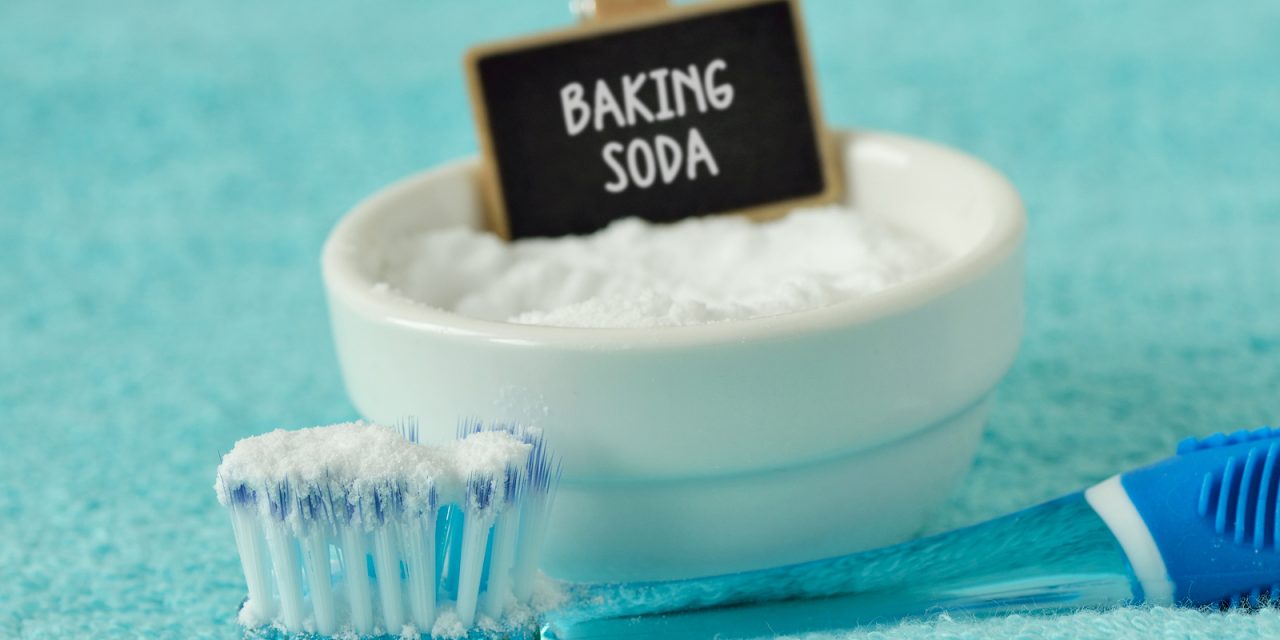Achieving a brighter smile is often found on many individuals’ personal care list, and the quest for teeth whitening solutions has spurred a variety of home remedies. Baking soda, scientifically known as sodium bicarbonate, is one such inexpensive and widely accessible product that has gained popularity for its teeth whitening properties. Its mild abrasive qualities can gently polish away surface stains from the teeth, providing an accessible method for those looking to enhance the whiteness of their smile.
It is important to approach baking soda teeth whitening with an understanding of oral hygiene and safety. While natural remedies like baking soda can be effective, they are not a replacement for daily oral hygiene practices or regular dental visits. Ensuring the correct application of baking soda, understanding its mechanism, and recognizing potential side effects are crucial to safely achieving the desired teeth whitening results at home.
Key Takeaways
- Baking soda is a low-cost, accessible product for home teeth whitening.
- Safe application of baking soda is essential for effective results.
- Regular oral hygiene and dental advice should accompany natural remedies.
Understanding Tooth Discoloration
Tooth discoloration is often a cosmetic concern that can affect the brightness and appearance of one’s smile. Knowing the types of tooth stains and their common causes is essential for effectively addressing and preventing discoloration.
Types of Tooth Stains
There are two primary types of tooth stains: extrinsic and intrinsic. Extrinsic stains are surface-level stains that affect the outer enamel layer of the teeth. They are often caused by pigmented foods and drinks such as tea, coffee, and wine, which contain intense color compounds that adhere to the tooth enamel.
Intrinsic stains, on the other hand, occur within the tooth itself and can be due to factors like aging or exposure to certain minerals during tooth formation. Over time, as the enamel wears down, the naturally yellower dentin beneath becomes more visible, contributing to an overall darker appearance of the teeth.
Common Causes of Discoloration
Multiple factors can lead to tooth discoloration, with dietary choices and lifestyle habits being significant contributors:
- Staining Foods and Beverages: Regular consumption of tea, coffee, wine, and certain fruits and vegetables can lead to extrinsic stains.
- Smoking: Tobacco products introduce tar and nicotine, which create stubborn extrinsic stains on the enamel.
- Aging: As individuals age, enamel thins and dentin darkens, naturally leading to a less white smile.
Preventing and managing tooth discoloration involves both understanding its origins and making informed choices in daily habits and dental care.
Preparation and Safety
When considering the use of baking soda for teeth whitening, prioritizing safety and the protection of dental enamel is essential. Proper preparation and understanding of the risks can help prevent long-term damage to your teeth.
Ensuring Safe Use of Baking Soda
Baking soda, or sodium bicarbonate, is known for its abrasive properties, which can be effective in removing surface stains from teeth. However, to ensure safe use, one should strictly adhere to the recommended ratios and frequency of use. A mixture of baking soda with water is typically suggested, forming a paste that is less abrasive than baking soda alone. Using this paste no more than once or twice a week can help maintain safety while utilizing its whitening benefits.
Avoiding Damage to Enamel
The enamel on teeth is susceptible to damage from overly abrasive substances. Baking soda, despite being a mild abrasive, can still harm enamel if used improperly. To avoid damage, it is advisable not to apply excessive force when brushing with a baking soda paste. Additionally, one should avoid using baking soda in conjunction with acidic foods or drinks, as the combination can heighten enamel erosion. It is also wise to choose a toothpaste containing fluoride to support enamel strength, especially if using baking soda for whitening.
Pre-Whitening Dental Checkups
Before starting any whitening regimen with baking soda, scheduling a dental checkup is crucial. Dentists can identify underlying issues, such as cavities or gum disease, that could be exacerbated by the use of abrasive materials. They can also offer advice on whitening methods suited to those with sensitivity or compromised dentin. Professional guidance ensures that one’s approach to tooth whitening with baking soda does not compromise safety and dental health.
The Science of Baking Soda Whitening
Baking soda, or sodium bicarbonate, is a common household product that doubles as a natural bleaching agent and mildly abrasive, making it a useful component in dental hygiene for stain removal and plaque reduction.
Baking Soda as a Mild Abrasive
When used in oral care, baking soda acts as a mild abrasive. Its gritty texture helps to gently polish away surface stains on teeth, contributing to a brighter smile without causing harm to tooth enamel. The relative abrasiveness of baking soda is lower compared to some commercial toothpaste abrasives, which allows for effective cleaning while minimizing the risk of abrasion to the teeth.
Chemical Properties for Stain Removal
Sodium bicarbonate possesses chemical properties that enhance its role as a stain remover. It’s a natural alkaline substance with pH balancing qualities, which helps to neutralize the acids produced by plaque. This not only aids in preventing tooth decay but also in breaking down the compounds that cause stains on the teeth. As a natural bleaching agent, baking soda facilitates the lightening of tooth enamel stains, leading to a whiter appearance of the teeth.
Combining Baking Soda with Other Natural Ingredients
When seeking to whiten teeth naturally, many individuals turn to baking soda due to its mild abrasive properties that help in removing surface stains. Combining baking soda with other natural ingredients can enhance its effectiveness, but it’s crucial to do so safely to protect the enamel and gums.
Hydrogen Peroxide and Baking Soda
Hydrogen peroxide is a common household ingredient and a natural bleaching agent. When mixed with baking soda, it forms a paste that can effectively whiten teeth. To create this mixture, one can combine two parts of baking soda with one part of hydrogen peroxide to form a consistent paste. It is recommended to use this method sparingly, as overuse could lead to enamel erosion.
Alternative Natural Whitening Mixes
Besides hydrogen peroxide, there are a variety of natural ingredients that can be paired with baking soda for teeth whitening. However, using acidic substances such as lemon juice or apple cider vinegar should be approached with caution due to potential enamel damage.
- Coconut oil is renowned for its oral health benefits, particularly through a process called oil pulling, which involves swishing oil in the mouth to reduce bacteria and whiten teeth. One can mix coconut oil with baking soda for a gentler whitening paste.
- On the other hand, despite popular claims, ingredients like strawberries and lemon may offer more risk than benefit due to their citric acid content, which can be harsh on tooth enamel.
For those seeking a natural approach, it is always essential to research and consider the potential impacts on dental health.
Step-by-Step Guide to Whitening with Baking Soda
Whitening teeth with baking soda is a straightforward process involving three main steps: preparing the whitening mixture, using the correct brushing technique, and thoroughly rinsing your mouth afterward.
Mixing Ingredients
To begin, one should mix 1/4 to 1/2 teaspoon of baking soda with a small amount of water to form a paste. The ratio is typically two parts baking soda to one part water.
- Ingredients:
- Baking soda (sodium bicarbonate)
- Water
Instructions:
- Measure the baking soda.
- Gradually add water until a paste forms.
Brushing Technique
Once the paste is ready, apply it to the teeth using a toothbrush. Brushing should be done with gentle, circular motions for two minutes to ensure even application without harming the enamel. One must avoid using any fruit juice to avoid acidic damage.
Rinsing Process
After brushing, it is crucial to rinse the mouth with water to remove all traces of the paste. Engaging in the rinsing process ensures that the abrasive residues from the baking soda are completely washed away.
Steps for Rinsing:
- Swish water around the mouth vigorously.
- Spit out the rinsing water.
Following this routine once every two weeks can enhance the brightening of one’s teeth, complementing the use of fluoride or regular toothpaste in daily oral hygiene.
Daily Oral Hygiene Practices
A consistent oral hygiene routine is crucial for maintaining a healthy smile and preventing dental issues. Flossing and brushing are fundamental to eliminating plaque buildup and reducing the risk of gingivitis, while oil pulling can complement these practices. Limiting the consumption of stain-causing beverages like tea, coffee, and wine is also beneficial for keeping teeth whiter and avoiding tartar formation.
Flossing and Brushing
One should floss at least once a day to remove food particles and plaque from between the teeth that a brush cannot reach. Flossing before brushing allows for the fluoride in toothpaste to better get between teeth. Brushing should occur at least twice daily with a soft-bristled brush for two minutes to effectively remove plaque and prevent tartar buildup, contributing to teeth yellowing. For enhanced cleaning, toothpaste containing baking soda can be especially effective in whitening teeth and removing stains.
Oil Pulling for Oral Health
Oil pulling, an ancient practice where one swishes oil in the mouth for a period of time, can complement daily brushing and flossing. This method has been suggested to help reduce plaque and promote oral health. Sesame or coconut oil is often used for pulling, and consistent practice appears to minimize bacteria that contribute to plaque and gingivitis.
Limiting Stain-Causing Beverages
The beverages one consumes can significantly affect the color of their teeth. Drinks like tea, coffee, and wine can leave behind stains. Limiting these beverages and rinse the mouth with water after consumption to minimize staining is advisable. Using a straw for cold beverages can also reduce contact with the teeth, reducing the potential for stains.
Assessing the Results
Evaluating the effectiveness of baking soda for teeth whitening involves looking at both immediate outcomes and its influence on oral health over time.
Short-Term Whitening Effects
After using baking soda as a whitening agent, individuals may notice that tooth stains become less visible, leading to a brighter smile. While some may expect their teeth to reach a dazzling white, the reality is that the whitening effects can be less dramatic yet noticeable. It is important to monitor these changes to avoid overuse, which could potentially damage enamel.
Long-Term Oral Health Impact
Continued application of baking soda can have mixed effects on dental hygiene. On one hand, it helps in reducing plaque and maintaining healthy gums. On the other, the abrasive nature of baking soda necessitates cautious use to prevent enamel wear over time. Regular dental check-ups are crucial to ensure that the pursuit of pearly whites does not compromise overall oral health.
Alternatives to Baking Soda
While baking soda is a popular home remedy for teeth whitening, several other methods are available to achieve a brighter smile. These alternatives range from over-the-counter solutions to professional treatments, each with differing ingredients and action methods.
Commercial Whitening Kits
Commercial whitening kits, which are readily available in pharmacies and online, offer a convenient at-home option. These kits typically contain whitening strips that are coated with a gel containing hydrogen peroxide or carbamide peroxide. The peroxide acts as a bleaching agent that lightens the color of the tooth enamel. It is essential to follow the instructions carefully to avoid gum irritation or overuse. Some kits also include LED light devices meant to accelerate the whitening process.
- Whitening kits typically include:
- Pre-filled trays
- Whitening strips
- LED light devices
- Key ingredients:
- Hydrogen peroxide
- Carbamide peroxide
Professional Dental Whitening
For those seeking immediate and significant results, professional dental whitening performed by a dentist can be preferred. Dentists use high-concentration peroxide gels that are not available over the counter. They may employ additional technologies such as special lights or lasers, which can enhance the whitening effect. While this option is more expensive than at-home kits, the results are typically more noticeable and achieved faster.
- Advantages of professional whitening:
- Use of high-concentration whitening gels
- Faster and more visible results
- Considerations:
- Higher cost
- The potential need for multiple visits
Both methods provide effective alternatives to baking soda, allowing individuals to choose based on their preference, budget, sensitivity levels, and desired outcome. It’s also worth noting that while over-the-counter options can be quite effective, it’s advisable to consult with a dentist before beginning any teeth whitening regimen, especially for those with dental restorations or sensitive teeth.
Understanding and Managing Side Effects
When using baking soda for teeth whitening, it is crucial to be aware of potential side effects and to know how to manage them effectively. These can include increased tooth sensitivity and gum inflammation, and there may be implications for long-term cavity protection due to its abrasive nature.
Tooth Sensitivity After Baking Soda Use
Individuals may experience heightened sensitivity after using baking soda on their teeth. This is often due to the abrasive quality of baking soda which, while effective at removing stains, can also wear down the enamel with excessive use. To mitigate tooth sensitivity, they should limit the use of baking soda to a few times per week and follow up with a fluoride toothpaste to help remineralize the enamel.
Potential Long-Term Consequences
Repeated use of baking soda without proper care can lead to more serious side effects, such as gum inflammation or the wearing away of tooth enamel. Over time, this may reduce the teeth’s natural cavity protection. To prevent these long-term consequences, they should be cautious not to brush too vigorously, use a soft-bristled toothbrush, and always dilute baking soda with water to lessen its abrasiveness. Regular visits to a dental professional can ensure that any developing issues are addressed promptly.
Regular Dental Visits and Professional Advice
Regular dental visits and consultations with a dental professional are crucial steps in maintaining oral health and ensuring the effectiveness of at-home treatments like using baking soda for teeth whitening. These visits allow for professional cleanings that remove plaque and tartar and provide an opportunity to receive personalized advice on dental care.
Scheduling Dental Cleanings
Dental cleanings, typically recommended twice a year, play a vital role in oral hygiene. During a cleaning, a dental hygienist removes build-up that regular brushing and flossing at home cannot, helping to prevent cavities, gingivitis, and periodontal disease. These cleanings also allow one to remove surface stains, contributing to a brighter smile.
Consulting with Your Dentist
Consulting with a dentist is essential before starting any teeth whitening regimen. A dentist can offer legal and **safe recommendations tailored to the individual’s needs. They can assess the suitability of baking soda as a whitening agent for a person’s specific dental conditions and ensure that the usage won’t compromise dental health. Additionally, regular dental checkups are important to monitor oral health and the progress of any teeth whitening efforts.
Frequently Asked Questions
This section addresses common inquiries on how to use baking soda for teeth whitening effectively. It covers the steps for use, potential side effects, recommended frequency, safe combinations with hydrogen peroxide, complementary natural methods, and the expected timeline for results.
What are the steps to use baking soda for teeth whitening?
To whiten teeth with baking soda, mix 1/2 teaspoon of baking soda with a small amount of water to create a paste. This mixture is then applied to the teeth using a toothbrush, gently brushing for two minutes before rinsing.
What are the possible side effects of using baking soda on teeth?
Using baking soda excessively may lead to enamel erosion due to its abrasive nature. Other side effects could include increased tooth sensitivity and gum irritation if used improperly.
How often should baking soda be used for teeth whitening?
Dentists generally recommend using baking soda for teeth whitening no more than once or twice a week to prevent enamel damage and maintain oral health.
Can baking soda and hydrogen peroxide be used safely together for teeth whitening?
Baking soda can be combined with hydrogen peroxide to whiten teeth; however, it should be done with caution to avoid irritation. The mixture should be more of a paste than a liquid and not be used more than once a week.
What natural methods can complement baking soda for whiter teeth?
Natural methods such as oil pulling with coconut oil and consuming crunchy fruits and vegetables that promote saliva production can complement the teeth-whitening effects of baking soda.
How long does it generally take to see results from teeth whitening with baking soda?
Results from teeth whitening with baking soda vary by individual, but some may notice a difference in as little as a few weeks with consistent, appropriate use.



















